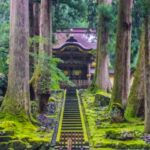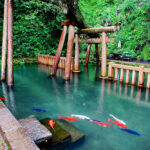-

-
Eiheiji Temple: Zen Training, Painted Ceilings, and Soul-Cleansing Power in Fukui
Eiheiji Temple, Fukui travel, Japan heritage sites, Japanese painted ceiling, Japanese temples, Michelin Green Guide Japan, Soto Zen temple, spiritual spots Japan, temple photography Japan, temple pilgrimage Japan, unsui monk training, Zen Buddhism Japan
Michelin Green Japan Pick! Eiheiji Temple, a Zen Sanctuary Eiheiji Temple was founded in 1244 by Dogen Zenji, the founder of the Soto school of Zen Buddhism. Within the grounds, over 70 buildings stand in harmony, with the seven main halls (shichido-garan) connected by covered walkways—each essential for daily Zen practice. The on-site Rurishōhōkaku Treasure Hall displays cultural treasures, including the Fukan Zazengi (National Treasure), said to be handwritten by Dogen himself. In 2015, Eiheiji received two stars in the Michelin Green Guide Japan, highlighting its spiritual and cultural significance. What Blessings Does Eiheiji Offer? Visiting Eiheiji is said to ...
-

-
“Kinomiya Shrine in Atami: A 2,100-Year-Old Sacred Tree & Spiritual Power Spot for Wishes and Wellness”
Atami travel, Instagrammable Japan, Japan shrines, japanese mythology, Kinomiya Shrine, power spots, sacred tree Japan, Shizuoka travel, spiritual spots Japan, unique shrines, wellness travel, wish-fulfilling spots
Kinomiya Shrine has long been revered as "Kinomiya Daimyojin," the guardian deity of Atami, and is deeply rooted in the region's spiritual culture as a bringer of good fortune and luck. According to legend, the origins of the shrine date back to the Nara period, when a wooden statue caught in a fisherman’s net was enshrined here. Kinomiya Shrine is also famously known across Japan as a rare “Deity of Sobriety,” making it quite unique. It’s about a 20-minute walk from JR Atami Station, or just a 5-minute walk from JR Kinomiya Station on the Ito Line. If you're coming ...
-

-
Kashima Jingu Shrine: Spiritual Power, Victory Blessings & the Sacred Origin of Japan’s Ley Lines
deer garden, ise jingu, japan power spots, japanese mythology, kashima jingu, kashima shrine, katori jingu, ley lines japan, mitarai pond, sacred places in japan, shrines in ibaraki, spiritual spots Japan, takemikazuchi, victory blessing shrine
Kashima Jingu Shrine: Spiritual Power, Victory Blessings & the Sacred Origin of Japan’s Ley Lines Kashima Jingu Shrine is said to have been founded in the very first year of Emperor Jimmu’s reign—660 BCE—according to ancient records. Until modern times, only three shrines in Japan held the prestigious title of “Jingu”: Ise Jingu, Katori Jingu, and Kashima Jingu, making this shrine truly exceptional in terms of history and spiritual significance. It is the head shrine of over 600 Kashima Shrines across Japan. The custom of praying for a safe journey at the start of a trip—known as *Kashima-dachi*—originated here. The ...
-

-
Pilgrimage Spot for Anime Fans: Visit the Real “Suzume’s Door” in Yamada, Iwate
anime pilgrimage Japan, anime sacred places, anime tourism, disaster site travel, earthquake memorial Japan, Japan hidden gems, Japan movie spots, Makoto Shinkai locations, real-life anime spots, spiritual spots Japan, Suzume film locations, Suzume no Tojimari, Suzume’s Door, Tohoku travel, Yamada Iwate
Pilgrimage Spot for Anime Fans: Visit the Real “Suzume’s Door” in Yamada, Iwate The Door from “Suzume” The second half of the anime film *Suzume*—which deals with the aftermath of the Great East Japan Earthquake—features the Sanriku coastal region as a key setting. For those who’ve seen the movie, you might recognize this spot: near a radio tower where Suzume’s childhood home once stood. The “backdoor” plays a symbolic role in the film. Search “Ano Tobira” (That Door) on Google Maps, and this location will appear! Makoto Shinkai’s *Suzume* is a story about loss and recovery set against the backdrop ...